Tharp's Thoughts Weekly Newsletter
-
Article:Transformation Through a Trading Metaphor, Part I by Van K. Tharp, Ph.D.
-
-
-
Tip: Ten Year Returns by Asset Class — Cool Visual Alert by D. R. Barton, Jr.
-
THIS SPRING WE ARE OFFERING OUR MOST POPULAR
PEAK PERFORMANCE WORKSHOPS!
What better time to begin a journey that will lead to personal and professional growth?
Immense success is possible for most traders and investors, but the secret to that success has little to do with some magical trading system. Instead, it has everything to do with you. You are the secret ingredient to your success. And when you transform yourself, you transform everything.

April 15-17
Peak Performance 101 is Dr. Tharp's core psychological workshop, and his most transformative course for over 20 years. If you want to know how great traders think, behave, and act, so you can achieve consistent and profitable results, without stress, then this workshop is for you.
April 19-22
Peak Performance 202 is a major leap forward for those of you who are willing to step out of your comfort zone. In Peak Performance 202, you’ll learn how to make a declaration for a trading vision that might seem all but impossible now. You’ll also learn how it is possible, and how you can take the first steps toward a new you, and success that’s beyond your current scope of understanding. This workshop is that powerful.
May 17-19
Peak Performance 203 - The Happiness Workshop Those of you who have finished the new edition of the Peak Performance Home Study Course know that Dr. Tharp describes several different models for self-sabotage:
- The Matrix Model says we are programmed to self-sabotage.
- The Creative Model says that when we disown our creations, we are committing self-sabotage.
- And the most significant model, Oneness, shows us that most of what we do, which keeps us in an ‘ego’ state, is self-sabotage.
Dr. Tharp has now discovered how to help people through these self-sabotage issues at the deepest level. And the basic concept is simple: When you are not doing what brings you joy, you are committing self-sabotage. Imagine moving toward being happier and happier, and at the same time becoming more and more successful as a trader. Well, that’s the core concept behind Peak Performance 203 Workshop: Avoiding Self-Sabotage by Following Your Bliss.
May 21-23
New! Modeling Great Trading Through Mental Strategies (Peak 204) The material presented in this new, advanced workshop is poised to make a dramatic impact on your life. While in attendance, you will gain understanding about how you are the central character in your story, and how you really create this story, and see how you can ultimately play an active role in shaping your own life. By thoroughly exploring how each of us uses mental strategies and the sequencing of thoughts, you will have the groundwork to continue to hone your skills throughout the workshop, and beyond.
Click Here to Register NOW!
Feature Article
Transformation Through a Trading Metaphor, Part I
by Van K. Tharp, Ph.D.
Click here to resolve formatting problems
Most of you probably know by now that our mission at the Van Tharp Institute is transformation through a trading metaphor. What do I mean by transformation? In this two-part article (Part Two coming next week), I’d like to cover several ways of looking at transformation including: David Hawkins’ level of consciousness model; the Matrix Model; and Going Beyond the Matrix. Let’s look at each of these.
Level of Consciousness
In his book, Power Versus Force, David Hawkins says that human consciousness can be measured on a log scale going from zero to 1,000. The level 1,000 is attained by only a very few masters — Jesus is one example. On the scale, 200 is considered to be the dividing line between constructive and destructive levels of consciousness. Below 200 are such emotions as anger, fear, shame, hatred, greed, pride, etc. In fact, let’s look at two specific levels, fear and greed. Fear, according to Hawkins, comes in at about 100 on the scale and greed comes in at about 125. Most people know that if you trade out of fear or greed, you will probably lose your money, and that’s because they are destructive mental states.
Acceptance, on the other hand, comes in on the scale at about 350. Now acceptance is a good state for trading because at this level you can accept losses and profits — both of which are a regular part of trading. In fact, acceptance of small losses is critical to successful trading. Thus, a minimum goal that I’d recommend for any trader is to reach a state of consciousness of 350.
So how do you measure one’s level of consciousness? David Hawkins says that you can measure it by kinesthetic muscle testing as long as the person doing the muscle testing calibrates at 200 or above — which is a minimum level for detecting truth. I have not been particularly happy with kinesthetic muscle testing as a measure of validity, however, Hawkins did say that one’s level of consciousness correlates with a person’s level of happiness. We measure happiness with a test that I developed. As someone goes through the Super Trader program, I like to see their happiness test scores get to 70 or above consistently by the time they finish the program. Below is a typical graph of what happens to someone’s happiness score when they are in the Super Trader program. The last two points on the graph show the increase in this Super Trader’s happiness score while making the transformations in the program. Most of the people who complete phase one of the Super Trader program end up with scores similar to this person although most don’t start the program at such a low level.
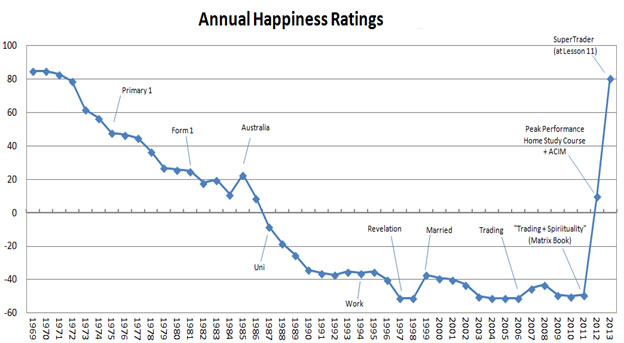
The Matrix Model
Most of you are probably familiar with the Matrix Model if you have read my book Trading Beyond the Matrix. If you have not read that book yet, we are currently giving it away for free on our website even though the retail list price is $40. To receive a free copy of the book, all you need to do is pay the postage, or drop by our office in Cary, NC and pick one up.
In the movie, "The Matrix", we see the story of how we are all like robots living ordinary lives and acting according to our programming. We think we are free, but we are really just programmed to act as a society and Madison Avenue want us to act. Some of us might have an idea deep down that there is a better way, but we have no idea what to do about it. In the movie, the hero Neo is given a choice: he could take a pill to learn about how he is programmed. In our case, I'm inviting you to read my book. Once you realize that you have the ability to affect your programming, you can then start to reprogram yourself and function much more effectively in the Matrix. You can even move beyond the Matrix. This is the third model of transformation (which will be discussed in part 2 of this article).
The Power of Language
Two forces have the biggest effects on our programming — our language and our beliefs. Let’s talk about language in this article and then move on to beliefs next week.
In 1933, Dr. Alfred Korzybski wrote a very famous book called Science and Sanity. Korzybski was very impressed by Albert’s Einstein’s form of thinking which Robert Dilts wrote about in the book, Strategies of Genius, Part II: Einstein. Korzybski wondered why science was able to progress so rapidly while society and psychology were not. His main conclusion was that “the map is not the territory, but just a structural representation of it.” Science tends to use mathematics as its primary language, which is structural in nature. Every other subject uses regular language — which is very misleading.
This means that words do not represent the object they name. The word dog, for example, is not the physical experience of dog, it is a representation consisting of letters (symbols) for an animal. The way you represent dog internally does not equal the external reality. Korzybski laid out many presuppositions of his ideas but we’ll cover just ten from his book, Science and Sanity. By the way, in this discussion (as in Korzybski’s 900-page book) the words used cannot convey the actual reality but only the symbolic representation of it.
- The map is not the territory. We tend to live so much by symbols that very often, we fail to distinguish between our symbols and the reality to which we refer, between our maps about reality and the territory of reality itself.
- If we reflect upon our languages, we find that at best they must be considered only as maps. Words are not the things they represent. The words we use about an object never cover the whole object. Whatever we say it is — IT IS NOT.
- The world is made up of physical vibrations. Our senses interpret the these vibrations and turn them into experiences — but our experiences are not the same as the vibrations. Color does not exist out there in the world. Color is a transformation created by the rods and cones in our retina as they abstract a certain vibration in the electromechanical wave length. So seeing color is a map of the world but not the world directly.
- Reality is structural, not verbal. It has pattern, form, and shape. There is a structure in every experience and that structure is the only source of knowledge.
- An object has many characteristics such as macroscopic, microscopic, and sub-microscopic. Most of these characteristics are unknown to us and they are not included in the word we give it, the object’s name. The characteristics that are left out are decisive and imply that lower and higher abstractions must never be confused in the same way that the object and its name are confused. Everything is unique because no two things are exactly the same. In other words, nothing is identical to anything else. At a microscopic level or below, everything is different.
- Everything must be treated as whole. The mind, for example, is not separate from the body. Moreover, we are joined to all things at subtle levels. This is a holistic view of the universe.
- Identifying (by using the verb to be) is the big problem in human thinking, speaking, and responding. To the extent that you identify (or over identify) you are confusing the map and the territory. Me saying “I am Van Tharp” is an example of this. Instead, I am an ongoing process who, through conditioning, calls himself Van Tharp.
- The challenge is to not over-identify with your beliefs, understandings, decisions, or intentions with reality. The challenge is to stay present, current, open and flexible. At the opposite end of the spectrum, you can become a "true believer" of your beliefs — so much so that you “cannot be wrong" or you "cannot be mistaken." Do that and you become a fanatic believer in your map. Problems, arguments, and wars are caused by over-identification or attachments to a particular map. To the extent you think you are right about any of your beliefs, you suffer from this form of “unsanity”.
- Aristotelian logic is absolutely misleading. In fact, anything on a verbal level tends to be misleading unless we recognize it for what it is … a high level of abstraction.
- The only similarity between a map and the territory is structural. Therefore, all knowledge is structural and we need language to focus on structure (as mathematics does) rather than high level abstractions.
In next week’s article, we will take these ideas about transformation and look at the other main area that Korzybski says affects our ideas about reality — our beliefs. We will also consider how someone might apply these concepts to trading better.
References
Hawkins, David. Power Versus Force: The Hidden Determinants of Human Behavior. Sedona, AZ: Veritas Publishing, 1998.
Dilts, Robert. Strategies of Genius, Part II: Einstein. Capitola, CA: Meta-Publications, 1994.
Korzybski, Alfred. Science and Sanity, 5th Edition. Fort Worth, TX: Institute of General Semantics, Inc. 1954 825 pages.
Tharp, Van K. Trading Beyond the Matrix, New York: Wiley, 2013.
About the Author: Trading coach and author Van K. Tharp, Ph.D. is widely recognized for his best-selling books and outstanding Peak Performance Home Study Program—a highly regarded classic that is suitable for all levels of traders and investors. You can learn more about Van Tharp at www.vantharp.com. His new book, Trading Beyond The Matrix, is available now at to our subscribers at no charge. Request your copy by clicking here.
|
Workshops
Combo Discounts available for all back-to-back workshops!
See our workshop page for details.
Trading Video
The Latest Swing Trading Videos From Ken Long
In preparation for the Advanced Swing Trading Workshop in July, Dr. Ken Long has been actively tracking swing trading opportunities and making short videos about them. In these two pieces, about 15 minute each, Ken provides updates on the series of trades that he began stalking about two weeks ago. In the first video made on Sunday, March 6, Ken discusses the importance of continued trade management for the dozen or so positions for which he had about +20R in hand. 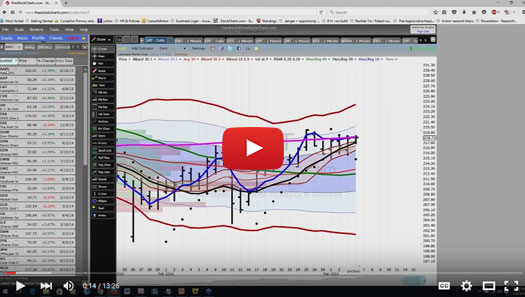
After the market close on Tuesday, March 8, Ken created another video reviewing the status of the positions – some of which had been closed and some of which were still open. 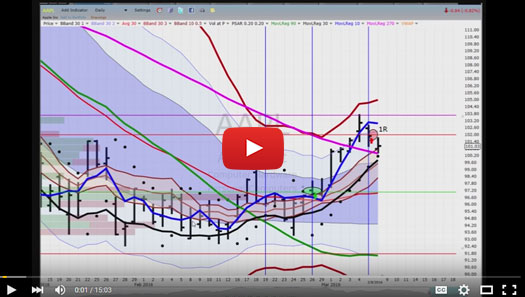
Trading Tip

Ten Year Returns by Asset Class — Cool Visual Alert
by D. R. Barton, Jr.
Click here to resolve formatting problems
My high school chemistry teacher, Ms. Duncan, made chemistry interesting and likeable for me and countless others through her tenure as an educator. Before I hit her class, I already loved science and thought I wanted to be a zoologist or a marine biologist. I believe it’s quite fair to credit her with launching me on my first career as a chemical engineer.
Given my background, it’s no surprise that I’ve spent more than a little time with a periodic table. While Dmitri Mendeleev’s graphic layout of elements was truly innovative, I realize that showing this graphic may cause a bit of “reliving bad school moments” for some. We need to get a quick look at a periodic table as a precursor to today’s market graphic but if it makes you queasy, avert thine eyes:

Click here for larger version.
The combination of a logical flow and the grouping of like elements combined with our current use of color has made the periodic table one of the most recognizable graphics in the world. An innovative investment consulting firm named Callan Associates has taken Mendeleev’s concept into the financial world.
Callan’s Periodic Table of Investments
While Callan’s Periodic Table of Investments doesn’t have the cool cutouts that make the chemical version so visually distinctive, I think you’ll agree that it does provide a wealth of information. Without further ado, take a look and then we’ll go through some info that it provides:
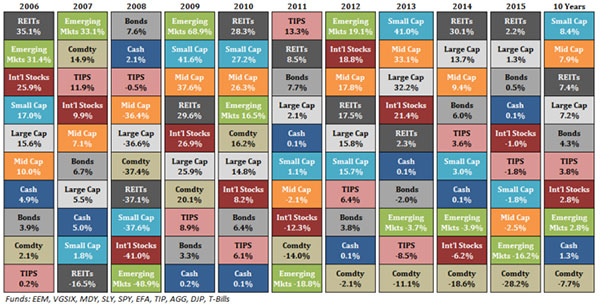
Click here for larger version.
This chart is just one of ten different versions that the company updates throughout the year. The columns designate years and each box represents the annual return for an asset class which is color coded (e.g. Cash = dark blue, Mid Cap = orange).
One of the most compelling features of the graphic is that your eye can quickly trace the relative performance of an asset class through the years. For example, you can see how the green colored Emerging Markets have been in mostly a “boom or bust” mode over the last ten years:
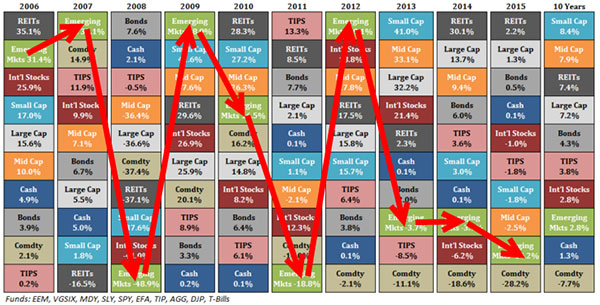
Click here for larger version.
Another feature that I really like about this version is the last column summary that gives the ranks the asset class averages for the full ten years.
Callan states that this tool “conveys the strong case for diversification across asset classes… and highlights the uncertainty of capital markets. Rankings change every year.”
In a future article, we’ll take a look at some other versions of this table that highlight other asset classes and investment styles.
Please let me know your thoughts and opinions on the article. Send your comments to drbarton “at” vantharp.com — I always enjoy hearing from you!
Great Trading,
D. R.
About the Author: A passion for the systematic approach to the markets and lifelong love of teaching and learning have propelled D.R. Barton, Jr. to the top of the investment and trading arena. He is a regularly featured analyst on Fox Business’ Varney & Co. TV show (catch him most Thursdays between 12:30 and 12:45), on Bloomberg Radio Taking Stock and MarketWatch’s Money Life Show. He is also a frequent guest analyst on CNBC’s Closing Bell, WTOP News Radio in Washington, D.C., and has been a guest on China Central Television — America and Canada’s Business News Network. His articles have appeared on SmartMoney.com MarketWatch.com and Financial Advisor magazine. You may contact D.R. at "drbarton" at "vantharp.com".
Free Book We're Giving You a FREE Book!
TRADING BEYOND THE MATRIX
The Red Pill for Traders and Investors
We pay for the book, you pay for shipping.
ALL YOU HAVE TO DO IS CLICK HERE!
Below is a brief video on how powerful this book is to traders.

Swing Trading Systems E-Learning Course
 The new Swing Trading Systems home study course is now available! Learn with Dr. Ken Long as he teaches his Swing Trading Systems Workshop via streaming video! The new Swing Trading Systems home study course is now available! Learn with Dr. Ken Long as he teaches his Swing Trading Systems Workshop via streaming video!
This new e-learning course includes Ken Long's Swing Trading Workshop, 5 swing trading systems and a bonus workshop featuring Van Tharp on Tharp Think principles. The course also includes extensive downloadable files to support your learning.
You can complete this course at your own pace, from the comfort of your own home or office, and access the materials as many times as you wish during your 1-year subscription period.
Take a look at this video from Ken to learn more about this course.
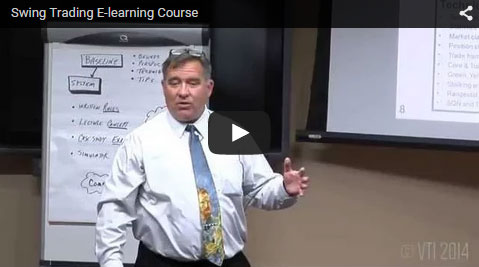
We have extensive information about the Swing Trading System e-learning course, including how to purchase...click the link below!
Learn More About The Swing E-Learning Course...
Matrix Contest
 Enter the Matrix Contest Enter the Matrix Contest
for a chance to win a free workshop!
We want to hear about the one most profound insight that you got from reading Van's new book, Trading Beyond the Matrix, and how it has impacted your life. If you would like to enter, send an email to [email protected].
If you haven't purchased Trading Beyond the Matrix yet, click here.
For more information about the contest, click here.
Ask Van...
Everything we do here at the Van Tharp Institute is focused on helping you improve as a trader and investor. Consequently, we love to get your feedback, both positive and negative!
Send comments or ask Van a question by clicking here.
Also, Click here to take our quick, 6-question survey.
Back to Top
Contact Us
Email us at [email protected]
The Van Tharp Institute does not support spamming in any way, shape or form. This is a subscription based newsletter.
To change your e-mail Address, e-mail us at [email protected].
To stop your subscription, click on the "unsubscribe" link at the bottom left—hand corner of this email.
How are we doing? Give us your feedback! Click here to take our quick survey.
Call us at: 800-385-4486 * 919-466-0043 * Fax 919-466-0408
SQN® and the System Quality Number® are registered trademarks of the Van Tharp Institute and the International Institute of Trading Mastery, Inc.
Be sure to check us out on Facebook and Twitter!
 
Back to Top |
|
March 16, 2016 #776
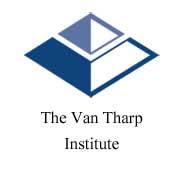
Our Mission
Van's Top-Twelve Favorite Trading Books
Van's Favorite Non-Trading Books
Viewing on-line eliminates spacing, and formatting problems that you may experience in your email program.

Ongoing Contest: Learn how you could win a $50 coupon and a grand prize of a free workshop!
www.youtube.com/vantharp
How are we doing?
Give us your feedback!
Click here to take our quick survey.
From our reader survey...
"I think the newsletter is
extremely generous and it is a resource I utilize constantly.
I have saved every single one
since I first subscribed."
Trouble viewing this issue?
View Online. »
Van Tharp You Tube Channel
Tharp Concepts Explained...
-
Trading Psychology
-
System Development
-
Risk and R-Multiples
-
Position Sizing
-
Expectancy
-
Business Planning
Learn the concepts...
Trouble viewing this issue?
View Online. »


Check out our home study materials, e-learning courses, and best-selling books.
Click here for products and pricing
What Kind of Trader
Are You? Click below
to take the test.
Tharp Trader Test
Back to Top

Introduction to Position Sizing™ Strategies
E-Learning Course
Perfect for auditory/visual learners who learn more effectively from an instructional format that is full of interactive features!
Only $149
Learn More
Buy Now
SQN® and the System Quality Number® are registered trademarks
of the Van Tharp Institute
|